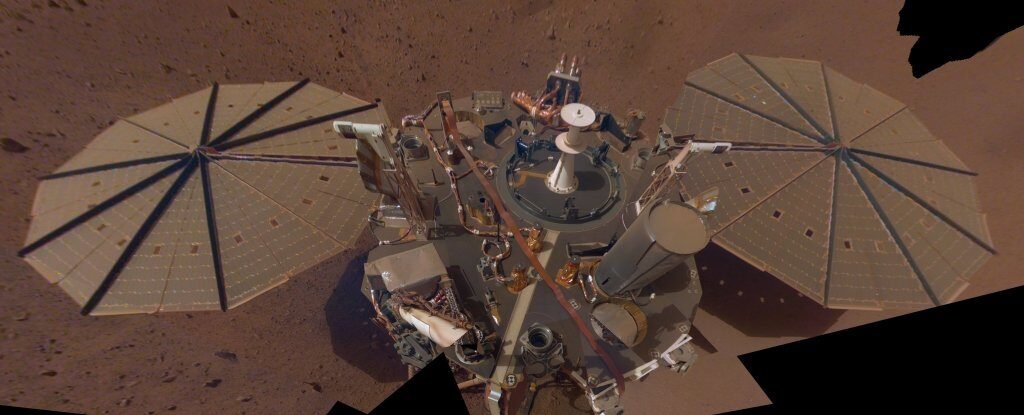
© NASA/JPL-CaltechMars InSight, covered in dust.
NASA's
Mars InSight lander has detected its three most powerful quakes yet.
On 25 August, InSight detected two quakes, at magnitude 4.1 and 4.2. Then, on 18 September - the lander's 1,000th Mars day of operation - it picked up the rumbles of another magnitude 4.2 quake.These new quakes blow the previous record of a magnitude 3.7 quake detected in 2019 out of the water. Fascinatingly, the largest of the August quakes was the most distant detected yet, with an epicenter some 8,500 kilometers (5,280 miles) from InSight.Analysis is still ongoing, but scientists are excited about the possibility of learning something new about the interior of the red planet.
"Even after more than two years, Mars seems to have given us something new with these two quakes, which have unique characteristics,"
said planetary geophysicist Bruce Banerdt of NASA's Jet Propulsion Laboratory.
InSight, squatting stationary on the surface of Mars, instrumentation primed to detect the rumbles and grumbles of the planet's belly,
has been operational since 2018. During that time, the lander has given us a wealth of new information.
First, there was the
direct detection of marsquakes in the first place. That's a big deal, because
Mars had been considered geologically dead. Now we know for certain that there's enough going on in the interior to keep things occasionally trembling.
Second, marsquake
data is allowing planetary scientists to map the Martian interior. When acoustic waves bounce around inside Mars and propagate through materials of different densities, the resulting signals can be decoded to work out what - and where - those materials are. It's how we
map Earth's interior, too. In this way,
scientists earlier this year determined that Mars has a larger-than-expected, low-density liquid core.
The newly detected quakes bring something new to the table.
Firstly
, almost all of the large quakes detected by InSight to date are from much closer to its landing site, in a region called the Cerberus Fossae, around 1,600 kilometers from InSight. Here, a series of fissures can be found, created by faults that pulled the crust apart. Evidence suggests that the region was tectonically and volcanically active recently, i.e., within the last 10 million years.
Scientists are yet to analyze the September quake, or precisely pinpoint the epicenter of the larger of the two August quakes, but
they're looking at another region that shows signs of past volcanic activity - Valles Marineris, a massive canyon system that gouges a 4,000 kilometer path across the face of Mars. The center of this system is 9,700 kilometers from InSight.
The two August quakes also
delivered different seismic profiles. The 4.2 magnitude quake was slow and low-frequency, and the 4.1 magnitude quake was faster and higher. It was also much closer, a mere 925 kilometers from the lander.Different seismic profiles can mean different processes at play within Mars, but they also help with the aforementioned Mars interior mapping, since they can help put together a more detailed reconstruction of interior densities.
InSight, the poor little ducky, hasn't exactly been having an easy time of it. First, it had
some issues with its burrowing instrument, the Mole, designed to monitor heat flow. The Mole was
pronounced dead earlier this year. And, although the lander received a two-year mission extension, it suffered some power issues when its solar panels became coated in dust.
In May of this year, scientists cleverly fixed this by directing InSight to trickle sand next to the solar panels on a windy day. The larger grains hit the panels and bounced off, collecting smaller dust in the process, resulting in a
significant power boost. The action was performed several times, restoring the lander's functionality.
"If we hadn't acted quickly earlier this year, we might have missed out on some great science,"
Banerdt said.
Comment: Is it possible that, as seems to be the case on Earth, and elsewhere in our solar system, that Mars is experiencing an uptick in various phenomena that point to a solar system-wide cosmic shift afoot?
- Volcanoes, Earthquakes And The 3,600 Year Comet Cycle
- Cosmic climate change: Is the cause of all this extreme weather to be found in outer space?
- Unusual green glow spotted in Mars' atmosphere
- Cosmic climate change: 'Space plasma hurricane' observed in ionosphere above North Pole!
- Planet-X, Comets and Earth Changes by J.M. McCanney
- Gulf Stream System at its weakest in over a millennium, last significant decline recorded during the little ice age
For more, check out SOTT radio's: